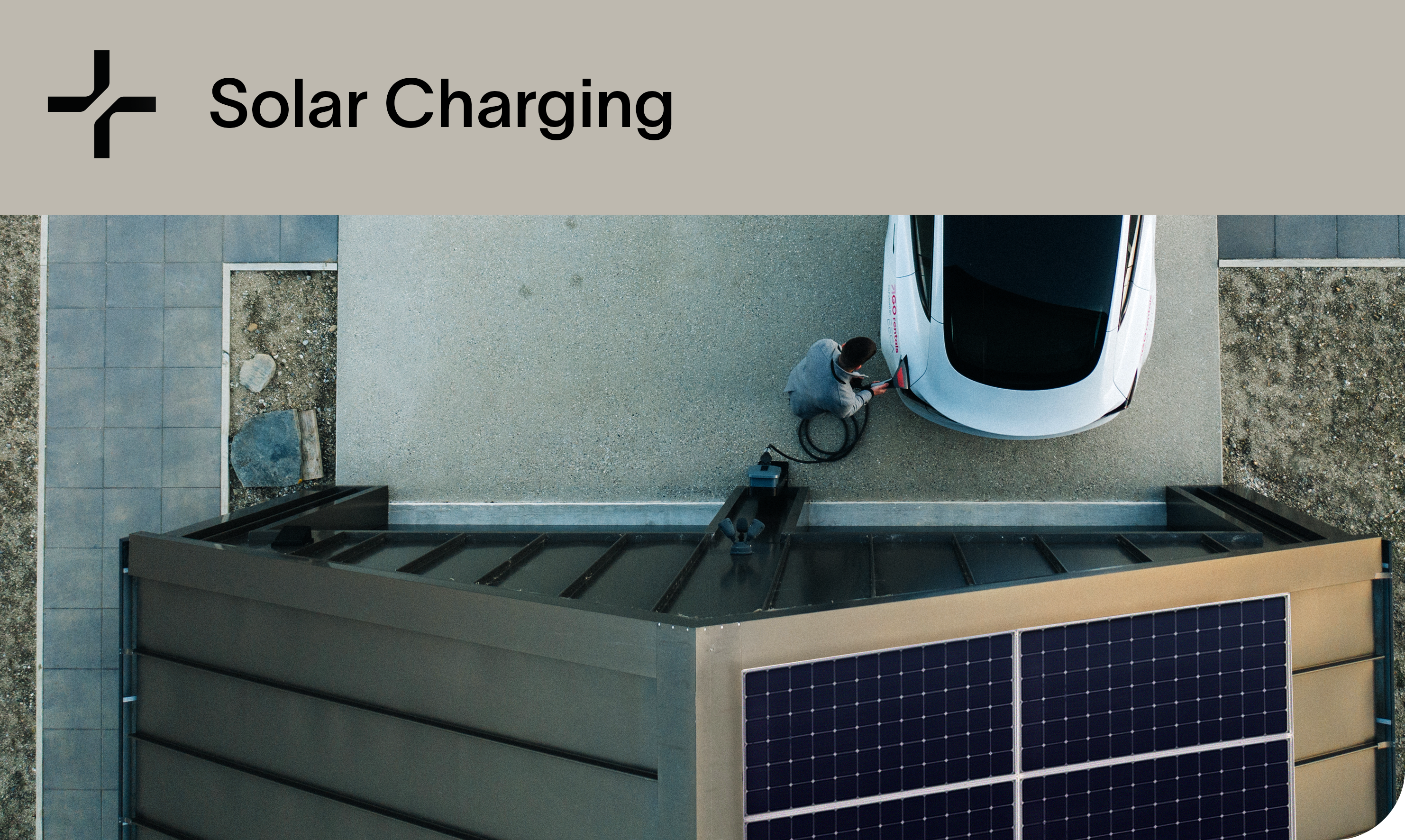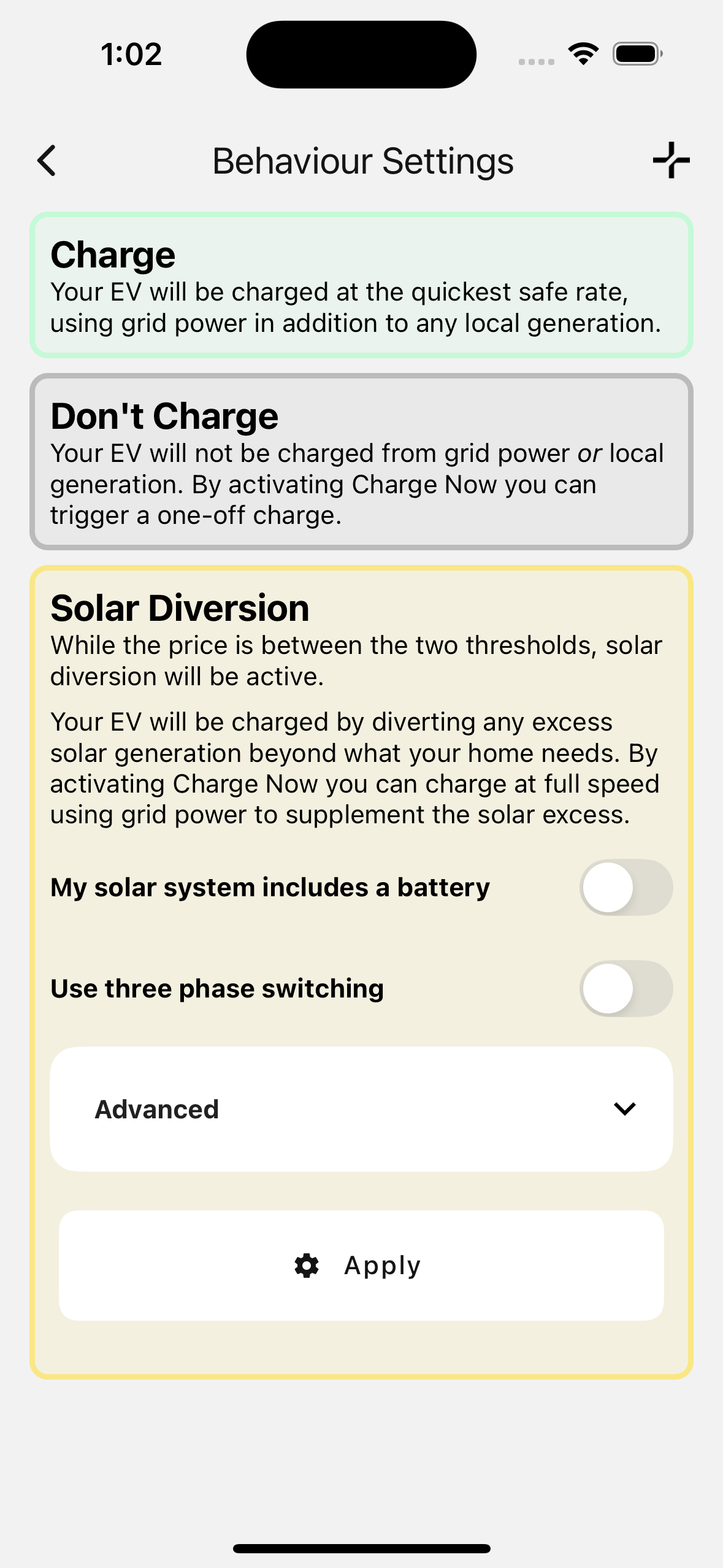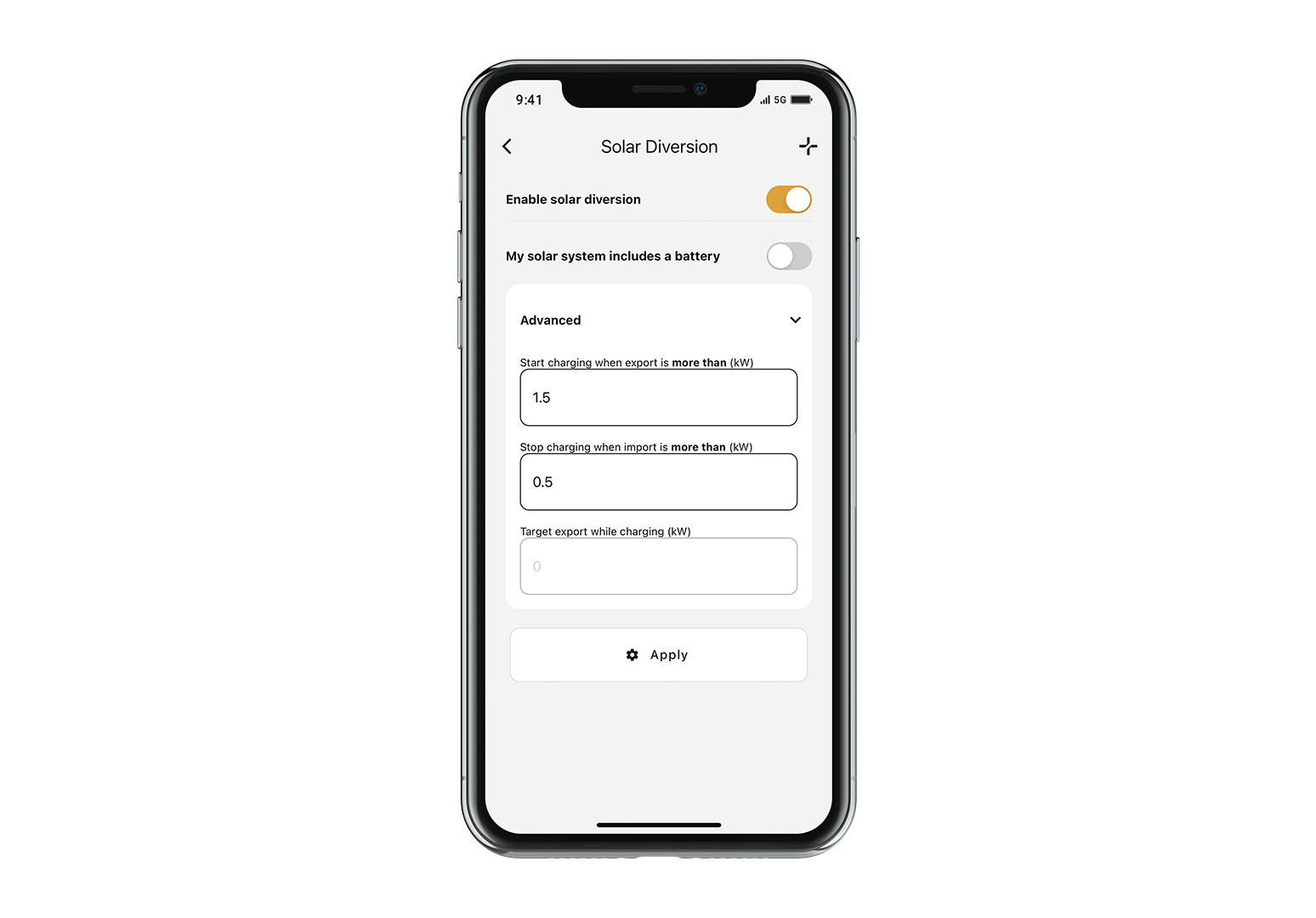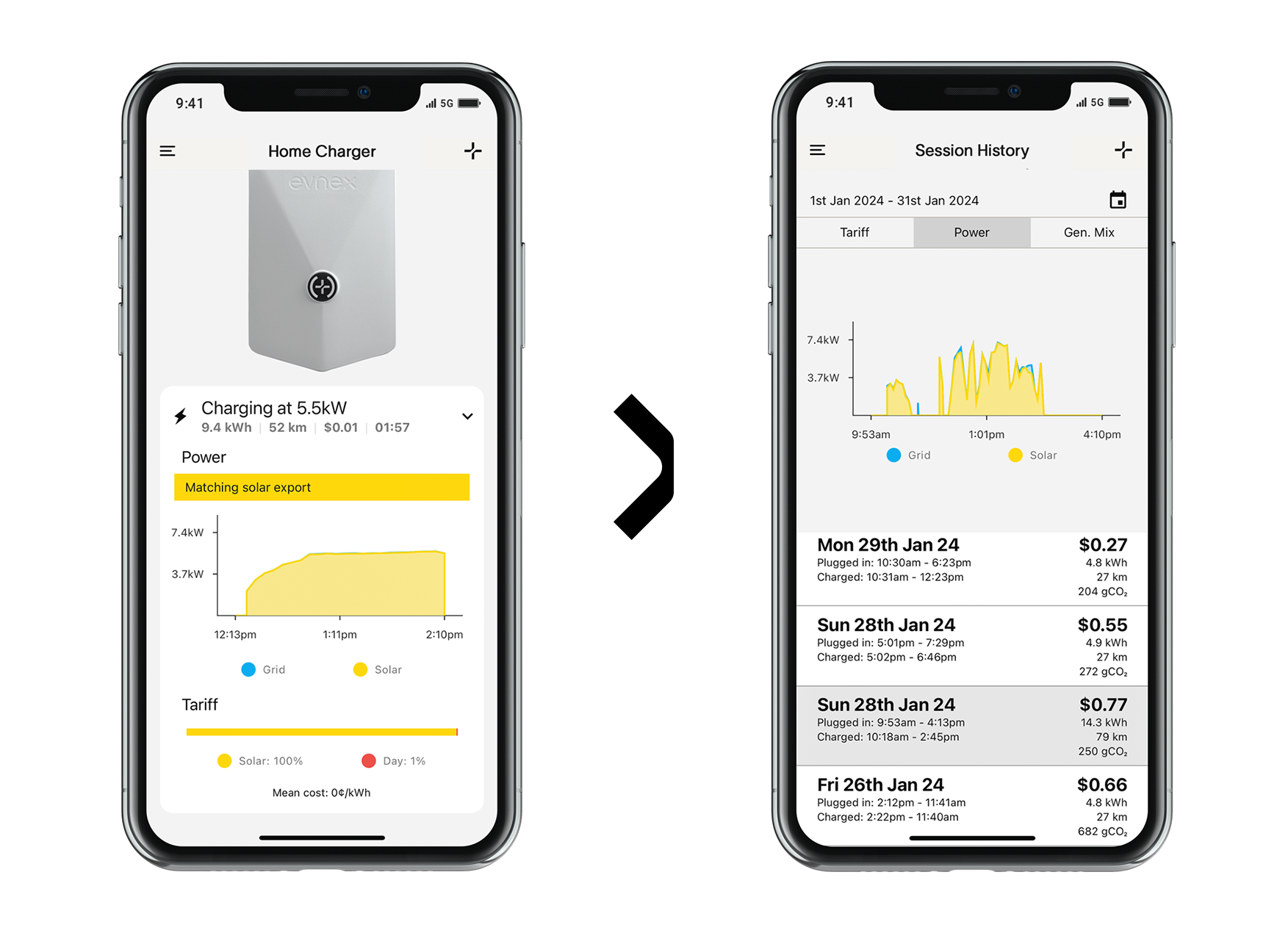Solar Charging
How to set up and use Evnex's Solar Diversion feature.

1. Solar charging with your Evnex charger
All Evnex chargers except the E2 Flex come with solar smarts. This lets you configure Solar Diversion to use your excess generation to charge your EV. The excess is measured by a current transformer which is included as standard with all home EV charging packages. Your electrician will install it as part of commissioning your charger.
Key Advantages
- Greater self-consumption of your solar energy
- Reduced energy costs
- Cleaner charging
2. How Evnex Solar Diversion works
Your Evnex charger will continuously monitor your home's power consumption. If your solar panels are generating more than is being used, this will result in an export to the grid. By enabling the Solar Diversion feature you can trigger the charger to use this excess power to charge the car instead.
How does this work alongside other smart loads?Evnex chargers act as the 'tail end' of an energy export diversion system. For example, if you have a home battery storage system, you cannot set up your charger to take priority and charge your car before directing power to your battery system - your car will always charge last (unless you use the Charge Now feature to override and charge immediately at full speed).
3. How do I set up Solar Diversion?
Solar Diversion is configured through the Evnex driver app alongside your tariffs and charging shcedule.
This video shows how to set it all up (solar diversion specifics start at 1:37):
After opening the app, scroll down the home screen and select the menu button labeled "Charging Settings", then select the "Behaviour" pencil icon. The Solar Diversion settings are under the Solar Diversion heading.
If your home solar setup includes a battery and the charger is wired such that the battery sees it as a load, we recommend you also turn on the second option, "My solar system includes a battery". Most chargers are actually wired so that the battery doesn't see it as a load, so if you aren't sure how the charger is wired then leave it off to start with, and then turn it on later if you find that your home battery gets drained filling up your car.
If you have an X22 three-phase charger then you will see the "Use three phase switching" option. This is turned on by default, and we recommend leaving it that way unless you find that your vehicle is unable to switch phases (at present we aren't aware of any that can't). This feature allows your charger to charge more slowly using just a single phase when there is a limited amount of excess solar available, such as during winter, or when you have lots of other appliances reducing the amount of exported solar available for the car.
Tap "Apply" to write the new settings.

I don't see the "Solar Diversion" menu?Most Evnex chargers installed in homes include a current transformer and are able to use this feature. However, due to site limitations where a current transformer cannot be installed, some drivers may lack the necessary hardware so this option is not available.
If you believe you meet the requirements for the Solar Diversion feature but can't see this option in-app, please contact our support staff for assistance. [email protected]
Including Solar Diversion in your Charging Schedule
Refer to the Charging Schedule guide on how to include Solar Diversion in your charging schedule. Select a behaviour of
"Solar Diversion" for any periods of time when you wish your charger to divert any excess solar into your vehicle.
You may wish to only charge from solar, but may find that the excess solar being generated during the day isn't enough to fill your car - perhaps you drive very long distances or it's winter and your panels aren't generating much.
If this is the case, you can update the Charging Schedule to set up a time to allow your charger to fill the battery using energy from the grid (the charge behaviour). Many drivers have cheaper power overnight, so setting a window of a few hours can ensure your car is full enough without paying too much.
Alternatively, if you just want a one-off full charge from the grid you can enable "Charge Now" either by holding the Evnex button on an E2 charger, or selecting Charge Now in the Controls menu option. This will ignore any solar or schedule settings and simply charge your car right now until either the battery is full or the charger is unplugged. The subsequent charging session will return to normal behaviour.
Advanced Solar Diversion settings
For most drivers, enabling Solar Diversion feature and (optionally) the battery toggle will give great performance. However, if you wish to tweak the triggers which control Solar Diversion behaviour, read on to find out about the parameters under the Advanced menu.
We recommend leaving the default values as they are unless you have a very good reason to change them.

Start charging when export is more than (kW)
The export threshold which must be exceeded for 60s before your charger will begin solar diversion.
It is important to note that the minimum current that an AC charger can offer to a car is 6A, which means that the minimum consumption is ~1.4kW charging on a single phase.
The default values are:
| Charging phases | Battery | Value (kW) |
|---|---|---|
| Single (E2 / X7 / X22 with phase switching ON) | No | 1.5 |
| Single (E2 / X7 / X22 with phase switching ON) | Yes | 1.9 |
| Three (X22 with phase switching OFF) | No | 4.5 |
| Three (X22 with phase switching OFF) | Yes | 4.7 |
How do thresholds work?The total import / export from your home is calculated by adding up all measured phases. On an E2 this is always just a single phase, but for an X-series charger this could be single or three phase.
It is therefore possible to have a single phase X7 charger monitor up to three phases and use the net total to decide whether to trigger solar diversion or not.
Stop charging when import is more than (kW)
⚠️ This setting is only relevant for systems without a battery. If you have enabled My solar system includes a battery then please see Stop charging when export is less than (kW).
When the stop import threshold is exceeded for 60s, solar diversion will be paused until such time as the start condition is met again.
The value should be at least 1.5kW away from the start threshold (i.e. “Start charging when export is more than”) for single-phase and phase-switching chargers, or 4.5kW away for three-phase chargers. We do permit numbers down to 1.5kW in case you have a three phase charger but a single phase car / cable. This limitation is to avoid the situation where the stop threshold is exceeded immediately when charging begins.
The default value is 0.5kW
Stop charging when export is less than (kW)
⚠️ This setting is only relevant for systems with a battery. If you have disabled My solar system includes a battery then please see Stop charging when import is more than (kW).
When the stop export threshold cannot be sustained for 60s, solar diversion will be paused until such time as the start condition is met again.
The value should be at least 1.5kW less than the start threshold (i.e. “Start charging when export is more than”) for single-phase and phase-switching chargers, or 4.5kW for three-phase chargers. We do permit numbers down to 1.5kW in case you have a three phase charger but a single phase car / cable. This is to avoid the situation where the stop threshold is exceeded immediately when charging begins.
The default value is 0.2kW
Target export while charging (kW)
While charging under solar diversion, your charger will vary the charging rate in an attempt to maintain this level of export to the grid.
If your solar setup does not include a battery, this will be set at zero so that solar diversion will aim to charge at the exact rate to cause neither import nor export.
For drivers with a battery, this number is your 'contingency' to ensure that the battery does not step in to contribute to charging your car. By intentionally exporting a small amount of power you ensure that the battery never detects a shortfall and thus never begins to discharge.
The default values are:
| Battery | Value (kW) |
|---|---|
| No | 0 |
| Yes | 0.2 |
4. Monitoring your Solar Diversion

Left: Charging Screen after receiving meter reading. Right: Session History
There are several ways you can monitor your solar diversion after completing the initial setup. This includes a visual graph displayed in several parts of the app including the expanded charging widget on the home screen, the Charging Summary and your Session History list.
5. Assistance with your Solar Diversion
If you're still unsure how to set up Solar Diversion for your charger or have questions, you can contact our support team for assistance during business hours at (NZ) 0800 395 007 | (AU) 1800 959 377 or email [email protected].
Updated about 1 month ago
Discover more smart features your EV charger has to offer...